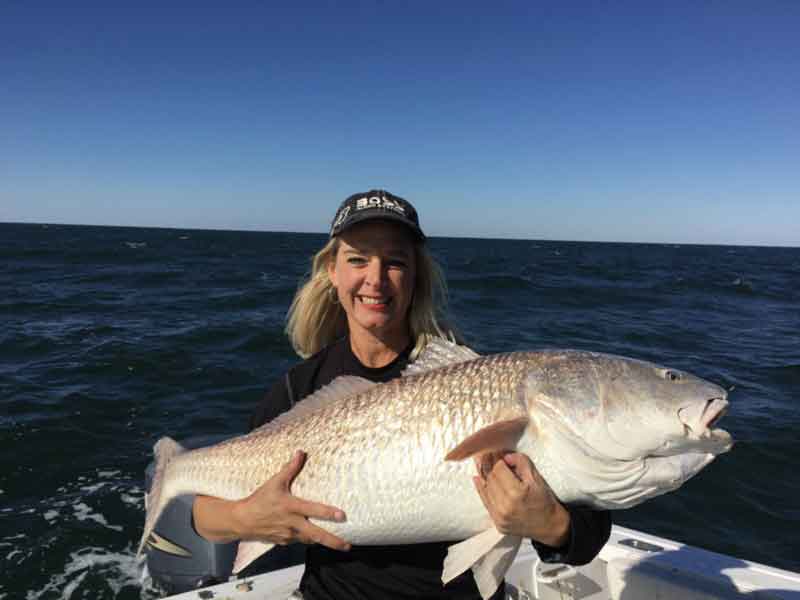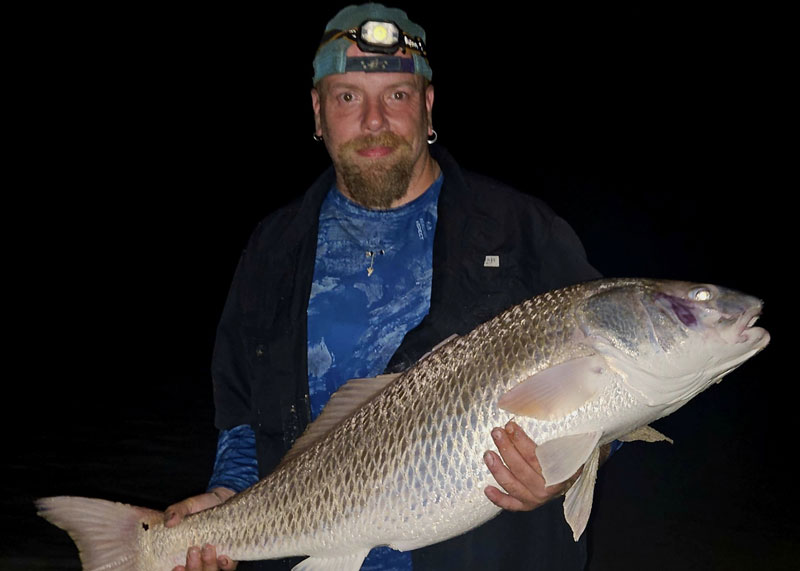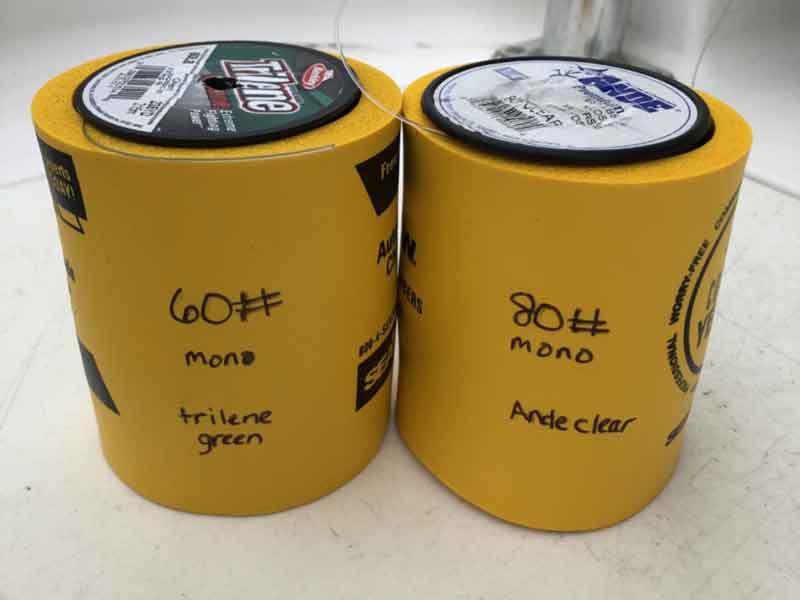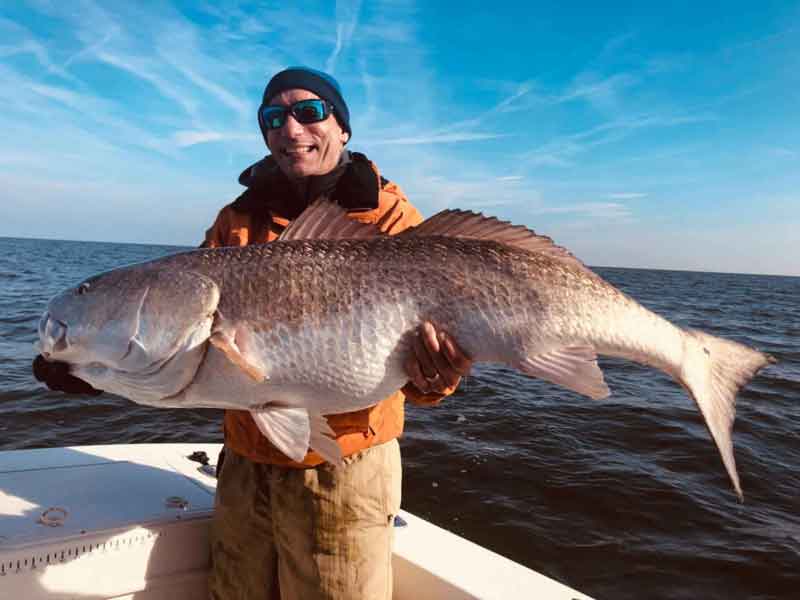When someone says the word “spring” to a saltwater angler who enjoys fishing in the southern Chesapeake, the run of bull redfish immediately comes to mind. Before indulging in the bite there are some elements to be aware of and a few essentials to gather, to hopefully avoid coming back to the dock with disappointed faces. Timing, tides, gear, bait, and more all come into play.

When to Go Fishing For Spring Red Drum
The earliest water temperature the drum are known to bite in the Chesapeake Bay is around 58 degrees. That temperature is usually found during April, but a more consistent drum bite can be found when the water temperatures reaches 60 degrees in May. The NOAA National Data Buoy Center website Station CBBV2 webpage is a great resource for finding out the current water temperatures near the mouth of the Chesapeake. Other signs the angler can look for are wisteria and flowering trees such as the dogwoods begining to bloom, a direct signal to us anglers that the drum are here.
Tides and Timing for Drum Fishing
As far as the specific time of day goes, the best drum action usually occurs around dusk when the reds move to the tops of the shoals to feed, often between six and 10 p.m. Sometimes they will bite just before dark and other times they’ll bite after dark, and of course a lot of this has to do with the tides and current. A really great time to catch drum is during the tide changes. The water is in motion when a tide changes and a moving current is very significant with drum. The change seems to turn the bite on and a key to taking advantage of this is to already have your boat in position, lines out with fresh baits on, just prior to the change. Being in position and anchored two hours before the low tide during a falling tide, for example, would be ideal.

Some angler’s may ask which tide is better. The truth is, they both have something to offer. If the tide is falling (high to low) the angler should look for adjacent points for the set up. Keep in mind that the red drum like to travel to slightly deeper water adjacent to the flats during this time, in their attempts to ambush the bait. If the tide is rising (low to high), then the shallower or “skinny” waters will be your better bet. Areas such as flats near the shore, oyster bars, and in the breakers are great places.
It’s important to know your boat's draft so you don’t run aground. Our boat, for example has an 18" draft, which tends to make large waves in shallow water a tricky situation – especially with increased wind and current, which can make the breakers at times a tad scary. You can also find some areas that go from shallow to deep in the upper shoals of the inner Middle Grounds. These areas are great for catching drum, especially during the outgoing tide, because some areas have slopes and go from shallow to deep which make great ambush points. Areas near buoys eight and 10 are also good places to try.
Gear For Monster Redfish
Rods and Reels
A seven-foot rod designed for medium to medium-heavy fast action is good. The rod tip should be able to hold a six to eight pound sinker gracefully (without bobbing continuously) but still have a somewhat reactive tip – thick broomsticks need not apply here. Pair that with a quality spinning reel size 6000 or 8000, or a quality conventional reel that has a large line capacity and can endure a big red peeling line.
Terminal Tackle
7/0, 8/0, or 9/0 J hooks or circle hooks (depending on angler’s preference) work well. You’ll want to have plenty of monofilament line for making leaders; I usually have 40, 50, 60, and 80-pound mono line on board. For best results, use the lighter pound test during the day and larger pound test at night.
Drum Bait
Live female blue crabs are excellent for spring. When using live bait keep in mind that the more active the crab is, the better. Lively baits attract and yield more fish.
Other Fishing Gear
- A large net is essential. Hand grips are also highly recommended, to help resuscitate the drum along the boat side before releasing the fish.
- Extra rods: have one rod pre-rigged with a jig head and curl tail jig – you never know when the opportunity to cast it to a fish will present itself and you want to be ready.
- It’s important to bring a head lamp with extra batteries and warmer clothes if you'll be out past dusk because it gets chilly in spring at night on the bay.
- Don't forget a measuring tape and camera (phone) for release citations.
- Extra swivels, fish finder rigs, and six, eight, and 10 ounce pyramid sinkers.
- Most important: Bring a positive attitude. Optimism is key to success!

Spring Red Drum Fishing Tips

- Since drum run in schools, keeping multiple lines in the water even after a drum is already on will often result in multiple hook ups. Although it’s a challenge to keep the lines from tangling, good communication and teamwork do pay off with multiple fish potentially being brought to the boat. On days with heavy winds, however, less is more, to avoid tangled chaos.
- Knowing the wind direction is also important for predicting fish behavior and bait presentation. A South or South West wind in the spring and North East wind in the fall is usually a good bet.
- If you have a successful trip make note of the tide and the time of the bite. When planning the next trip, you can factor in the potential bite time that matches up with the tidal cycles.
- Red Drum are more inclined to hit in the day when its overcast, darker skies, and/or cloudy with rougher seas. The rougher the water the better, because they love aerated water.
- Be aware that when the water reaches about 70 degrees, the drum start to spread out and there tends to be less of a concentration of the fish.
Note that fishing for these spring bulls is a very different fishery than it is in summer and fall, and even more different from pursuing slot redfish in Rudee or the other area inlets.
-By Beth Synowiec
Editor's Note: This article was originally published in March of 2020 and was last updated on May 9, 2024.